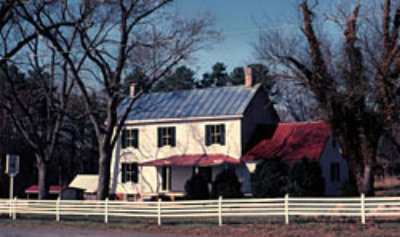
Courtesy of Virginia Department of Historic Resources
Piney Grove is an instructive example of evolutionary expansion, or the layers of history revealed in the architecture of a building that has changed over time. The original eastern portion of Piney Grove is a rare example of early log architecture in Tidewater Virginia, constructed c. 1790 as a corncrib. It was part of the 300-acre plantation of Furneau Southall, deputy sheriff of Charles City County, under Ottway Byrd, son of William Byrd III of Westover. During the Revolutionary War, Southall served on the Charles City County Committee of Safety with John Tyler, father of President John Tyler of Sherwood Forest and held a captainship of one of the county's companies, under Benjamin Harrison of Berkeley. Southall was also responsible for the local administration of the first Federal Census in 1790. Virginia's prominent Southall family first settled in Charles City County during the early 18th century. Other family members included James Barrett Southall, the owner of Williamsburg's Raleigh Tavern; Turner Southall, who served on the committee to build Thomas Jefferson's Capitol and historian Douglas Southall Freeman.
The log corncrib was transformed into a general merchandise store in 1820, which served this part of rural Charles City County for some 85 years. Such general stores were often gathering places and played an important role in 19th-century social life. Furneau Southall's grandson, John Stubblefield, expanded the store in 1853 with a single-room frame addition. The plantation remained in the Southall family until 1857 when John Stubblefield sold the property to Edmund Saunders. Following the Civil War Saunders moved to Richmond and became a successful wholesale grocer, although he did return to Charles City to purchase properties for agricultural production. In 1905 Thomas Harwood enlarged Piney Grove with a two-story frame addition as part of its transformation into a modern country residence, complete with an indoor kitchen and carbide lighting. Harwood served as a color sergeant during the Civil War and lost his leg at Malvern Hill. His battle injury was treated by Captain Sally Tompkins, who established one of the South's most important hospitals in Richmond and became the Confederate army's only female officer. Harwood subsequently re-enlisted, but was captured at Gettysburg. Piney Grove was abandoned from 1964 until 1984 when the Gordineer family undertook a five-year restoration of the house and grounds.
Piney Grove was listed on the Virginia Landmarks Register on June 18, 1985 and the National Register of Historic Places on November 26, 1985. For more information please visit: Piney Grove at Southhall's Plantation or call: 804-829-2480.
Last updated: September 21, 2016
